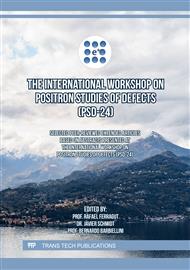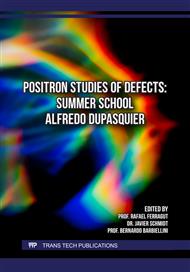[1]
G. Fabri, G. Poletti, and G. Randone, Phys. Rev. 151, 356 (1966).
Google Scholar
[2]
R. Fieschi, A. Gainotti, C. Ghezzi, and M. Manfredi, Phys. Rev. 175, 383 (1968).
DOI: 10.1103/physrev.175.383
Google Scholar
[3]
M. J. Puska and R. M. Nieminen, Rev. Mod. Phys. 66, 841 (1994).
Google Scholar
[4]
R. Krause-Rehberg and H. S. Leipner, Positron Annihilation in Semiconductors (Springer, Berlin, 1999).
DOI: 10.1007/978-3-662-03893-2_3
Google Scholar
[5]
F. Tuomisto and I. Makkonen, Rev. Mod. Phys. 85, 1583 (2013).
Google Scholar
[6]
J. Slotte, I. Makkonen, and F. Tuomisto, in: Characterisation and Control of Defects in Semiconductors, edited by F. Tuomisto, (IET, London, 2020), chap. 6.[7] D. V. Lang, J. Appl. Phys 45(7), 3023 (1974).
DOI: 10.1049/pbcs045e_ch6
Google Scholar
[8]
E. Schubert, Doping in III-V Semiconductors (Cambridge University Press, New York, 1993).
Google Scholar
[9]
C. D. Beling, S. Fung, H. L. Au, C. C. Ling, C. V. Reddy, A. H. Deng, and B. K. Panda, Appl. Surf. Sci. 116, 121 (1997).
Google Scholar
[10]
J. M. Mäki, F. Tuomisto, A. Varpula, D. Fisher, R. U. A. Khan, and P. M. Martineau, Phys. Rev. Lett. 107, 217403 (2011).
Google Scholar
[11]
J. Slotte, K. Saarinen, A. Salmi, R. Aavikko, S. Simula, and P. Hautojärvi, Phys. Rev. B 67, 115209 (2003).
DOI: 10.1103/physrevb.67.115209
Google Scholar
[12]
S. Valkealahti and R. M. Nieminen, Appl. Phys. A 35, 51 (1984).
Google Scholar
[13]
A. F. Makhov, Sov. Phys. Sol. State 2, 1934 (1961).
Google Scholar
[14]
A. van Veen, H. Schut, M. Clement, J. de Nijs, A. Kruseman, and M. IJpma, Appl. Surf. Sci 85, 216 (1995).
DOI: 10.1016/0169-4332(94)00334-3
Google Scholar
[15]
J. V. Olsen, P. Kirkegaard, N. J. Pedersen, and M. Eldrup, phys. stat sol. (c) 4, 4004 (2007).
Google Scholar
[16]
J. Kujala, N. Segercrantz, F. Tuomisto, and J. Slotte, J. Appl. Phys. 116, 143508 (2014).
Google Scholar
[17]
J. Gebauer, M. Lausmann, F. Redmann, R. Krause-Rehberg, H. S. Leipner, E. R. Weber, and P. Ebert, Phys. Rev. B 67, 235207 (2003).
DOI: 10.1103/physrevb.67.235207
Google Scholar



